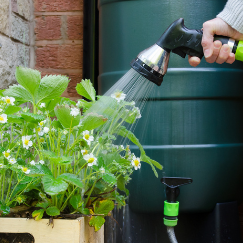How to Drought-proof your Garden this Summer

With the arrival of another summer of exceptional heat, learnings from last year tell us to be super smart about when to water our gardens and green spaces, conserving moisture wherever possible and ensuring our gardens are as drought-proof as possible.
Time to Water
Protect plants and conserve water supplies by watering plants at the optimum time – in the cooler parts of the day, early morning or evening to minimise evaporation. There is also a thinking that early morning is the better time because plants start to draw water again, instead of evening time, when damp leaves may encourage fungal disease and potentially attract slugs and snails. Sarah Squire of Squire’s Garden Centres, comments: “Do remember to water the base of plants, rather than the leaves. This helps lessen water wastage because moisture gets straight to the roots. Be mindful about water sources too – think of re-using washing up or bath water on ornamentals (but not vegetables) and use a watering can instead of a hose.” Helpful product: Value Watering Can 10 litre – £10.99
Looking ahead, a water butt is a great investment for this year and future years, enabling rainwater from gutters (when it arrives) to be used to hydrate the garden. They come in various sizes and, with many people now on water meters, there is a great money-saving opportunity too, with added environmental benefits. Helpful product: Space Saver Water Butt Kit 100 litre – £49.99
Sun Protection
The application of a mulch of bark – or light decorative stones – can work well as a topping to soil, helping stop plants drying out and retain moisture for longer. This remedial action can also help if there are any roots visible on the surface which can burn in the sunlight unless covered.
Helpful product: Bed & Border Chipped bark 70 litre £9.99 / 2 for £18
In the heat of the day, move plants in containers to shaded areas to conserve moisture and protect plants. Container grown plants will naturally dry out faster than plants in the ground, so it’s a good idea to move pots to shadier parts of the garden to provide extra protection or put a sunshade over precious plants shielding from the scorching sun.
Planting in the heat?
It is possible to plant in the heat however, additional care and attention will be needed. Water the plant well before planting – soaking the base of the plant in a bucket of water is a good way to do this. Watering the soil where you are going to plant prior to planting, will also help. Water well immediately after planting. If planting in a pot, position newly planted shrubs and blooms in a shadier part of the garden until the hottest period of the day has passed – and again, water daily as required. Think about choosing native Mediterranean plants which have evolved in dry soils with little rainfall and are growing in popularity. Plants to consider introducing to the garden as our summers become warmer include Lavender, Rosemary, Ceanothus, Verbena, Sedum, Agapanthus, hardy geraniums and Heuchera among others. Consider a product that contains water storing crystals, which can be mixed with compost at the time of planting. The crystals absorb moisture and lock it away until the compost becomes dry, then the gel releases water, helping keep the compost moist and reducing water requirements. It’s an ideal solution for baskets, pots and containers. Helpful product: Aqua Gel 400g – £9.99
Don’t Stress Plants
There are some simple things to avoid unnecessary stress on plants and grass such as not cutting grass too short as this can cause damage to lawns and soil beneath. Sarah comments: “Taller grass can create a shadow, helping retain moisture by not over-exposing the soil beneath, this will also help avoid brown patches that are a result of effects of the sun.”
Don’t keep greenhouses shut! These great growing spaces only become hotter in the sun, again another source of stress to plants. So, keep windows and doors open to allow airflow. For plants, fruit or veg struggling, consider moving to shadier spaces, if possible.
Lovely Lawns
While there are a few ‘don’ts’ to looking after lawns during hot spells – delay feeding until some moisture is forecast, don’t mow so often (and add some shade where possible) – it is vital any rain reaches beneath the surface. As the ground becomes hard with prolonged dry periods, welcome rain often runs off the surface and doesn’t easily soak in. To help water get to the roots, spike or aerate the lawn before rain is expected. This will ensure moisture goes deeper beneath the surface and encourages the roots to grow away from the hot/dry surface and down into the cooler, damp soil.
Sarah comments: “Our weather patterns are changing with warmer drier periods set to continue in summers to come, so now is a good opportunity to think about the autumn planting of trees and larger plants which provide shade. In addition, once they are established, larger trees and plants have deeper roots, allowing them to access water further down in the soil that is inaccessible to smaller plants. Perhaps a timely opportunity to think big when autumn comes and find space to plant some natural shade-givers.”
As the warm weather continues, demand for water will increase and there is the strong possibility of hosepipe bans coming into effect, so be prepared to water plants without the use of hosepipes and in accordance with any local restrictions put in place by water companies, using greywater where possible.
Finally, remember to look after yourself as well as your plants. Aim to work in the outside in the cooler times of the day, which is better for both plants and people. Do wear a hat, use sun lotion, cover up with light garments, drink plenty of water and take regular breaks out of the sun.






